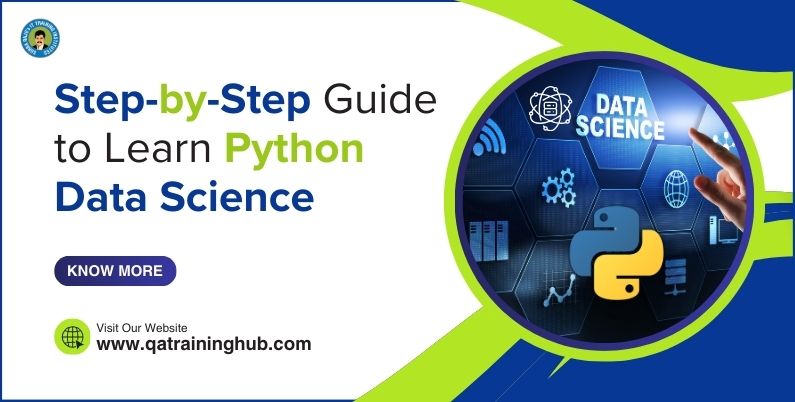
A Simple Guide to Mastering Data Science with Python Step by Step
Python has become one of the most popular languages for data science because it is simple and versatile. In today’s world where data is crucial, the demand for skilled data scientists is rapidly increasing. Whether you’re new to programming or already experienced, this article gives the Step-by-Step Guide to Learn Python Data Science
Understanding the Basics of Python:
Before starting with data science, it’s important to understand the basics of Python. Begin by learning about variables, data types, loops, conditional statements, and functions. There are many resources are available to help you learn these basics.
Familiarize Yourself with Python Libraries:
Python is great for data science because it has many libraries made for handling, analyzing, and visualizing data. Key libraries include NumPy for numerical computing, Pandas for data handling and analysis, Matplotlib and Seaborn for visualizing data, and Scikit-learn for machine learning.
Mastering NumPy:
NumPy is a crucial tool for scientific computing in Python. It offers strong data structures for handling multi-dimensional arrays and matrices. It also includes a range of mathematical functions to work with these arrays. Take the time to learn about NumPy arrays, how to access and manipulate them through indexing and explore the various operations you can perform on them.
Explore Pandas in depth:
Pandas revolutionizes how you handle and analyze data in Python. Its DataFrame and Series data structures simplify working with structured data. Discover how to load data into Pandas, manipulate it by filtering, sorting, grouping, and merging, and effectively manage missing data.
Data Visualization with Matplotlib and Seaborn:
Visualizing data is important for understanding its patterns and insights. Matplotlib is a flexible library that allows you to create static, interactive, and animated visualizations in Python. Seaborn, which is based on Matplotlib, offers an easy-to-use interface for creating attractive and informative statistical graphics. Try out different kinds of plots, personalize them, and discover how to effectively communicate your data through visualization.
Introduction to Machine Learning with Scikit-learn:
Once you feel confident with manipulating and visualizing data, it’s time to explore machine learning. Scikit-learn is a straightforward and effective tool for data mining and analysis, depending on NumPy, SciPy, and Matplotlib. Begin by grasping fundamental machine learning concepts, such as supervised and unsupervised learning. Then, move into popular algorithms like linear regression, decision trees, and k-nearest neighbors, all available in Scikit-learn.
Hands-on Projects and Real-world Applications:
To really understand Python data science, the best approach is to get hands-on with projects and real-life applications.Choose projects that interest you, such as analyzing financial data, or classifying images. Kaggle, a platform where data science competitions take place, provides many datasets and contests to help you improve your skills and work with other data enthusiasts.
Advanced Topics and Specializations:
As you progress in your data science journey, consider exploring more advanced topics and areas that match your interests and career goals. This could mean learning about deep learning with tools like TensorFlow and PyTorch, exploring natural language processing (NLP), understanding big data technologies like Apache Spark, or focusing on specialized fields such as bioinformatics or geospatial analysis.
Continuous Learning and Community Engagement:
Data science is a field that’s always changing, so it’s important to keep up with the newest trends, techniques, and technologies. Get involved with the data science community by joining forums, attending meetups, and participating in online groups and social media. Follow experts, join conversations, and contribute to open-source projects to grow your skills and connect with others who share your interests.
Conclusion:
At QA Training Hub, we believe in empowering individuals with the skills needed to succeed in today’s competitive job market.Learning Python for data science is an exciting journey that can lead to many career opportunities. By following this Step-by-Step Guide to Learn Python Data Science, you’ll not only learn the technical skills for analyzing and understanding data but also develop the problem-solving mindset crucial for data science.
Our training programs are designed to meet the needs of learners at every level, from beginners to advanced practitioners. We provide hands-on projects, real-world applications, and ongoing support to help you stay ahead in your learning journey. Whether you’re aiming to become a data scientist, data analyst, or simply want to improve your data-driven decision-making abilities, QA Training Hub is here to support you every step of the way.
Discover the potential Step-by-Step Guide to Learn Python Data Science,explore the field of data science, and elevate your career with QA Training Hub. Start your journey today and take the initial step toward mastering Python for data science.
FAQ’s:
Q: What is the best way to start learning Python for data science?
A: Begin by learning Python basics such as variables, data types, loops, and functions.
Q: Which Python libraries are essential for data science?
A: NumPy, Pandas, Matplotlib, Seaborn, and Scikit-learn are essential libraries.
Q: What is NumPy used for?
A: NumPy is used for numerical computing and handling multi-dimensional arrays.
Q: How can I manipulate data in Python?
A: Use Pandas for data manipulation and analysis.
Q: What are the key libraries for data visualization in Python?
A: Matplotlib and Seaborn are key for creating various data visualizations.
Q: What is Scikit-learn used for?
A: Scikit-learn is used for implementing machine learning algorithms and models.
Q: Where can I find datasets and projects to practice Python data science?
A: Kaggle offers numerous datasets and competitions for practice.
Q: What are some advanced topics in data science to explore?
A: Deep learning, natural language processing, and big data technologies.
Q: How can I stay updated in the field of data science?
A: Engage with the data science community, follow thought leaders, and participate in discussions.
Q: Is continuous learning important in data science?
A: Yes, staying updated with the latest trends and techniques is crucial.

